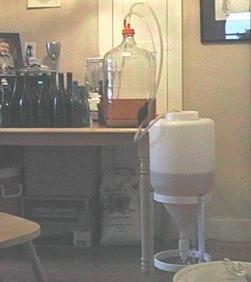Richard's Dry Sparkling Mead Recipe | |
Specifications:
|
Ingredients:
|
Preparing a Yeast Starter:Dissolve 4 oz honey and a pinch of yeast nutrient in a pint of boiling water, pour into a sterilized quart bottle (with a cotton-ball stopper), and let cool down to room temperature. Shake well to aerate, inoculate with the Wyeast smack-pack, and place in a warm cupboard to ferment for 2-3 days. For flavor, I personally prefer the Yeast Culture Kit Company's W06 Champagne Yeast, but starters must be stepped up from a slant, which is fiddly and takes a bit longer than using a smack-pack. Brewing the Mead:
Boil a gallon of the water, and use it to dissolve the honey in a sanitized 6-gallon tub. Mix in the yeast nutrient and acid blend. When all these ingredients are completely dissolved, stir in the remaining 4 gallons of cold water, splashing the mixture vehemently with a sanitized slotted spoon to oxygenate it. Transfer the honey "must" into a sanitized 6-gallon glass carboy. Do NOT boil the honey-water mixture, since this drives off the aromatic volatiles, and results in a rather insipid mead. A few wild yeasts from the honey cause no harm, and bacteria won't get much of a chance to grow if you're using a vigorous yeast culture! If one were fanatical about destroying wild microflora, the must could be sterilized by adding 10 Campden Tablets (100 ppm sulphite), then pitching the yeast 24 hours later. Pitch the yeast starter when the honey liquor has cooled to around 75 deg F, and fit an airlock to the carboy. Vigorous fermentation should be evident within 2-3 days; the primary fermentation takes 3-4 weeks at 65 deg F, after which the yeast settles out and airlock activity gradually ceases. Clarifying and Bottling:Siphon (rack) the mead off the yeast cake into another 5-gallon carboy. Dissolve the Sparkolloid finings in a cup of boiling water, and pour this mixture into the mead. Considerable clarification will occur over the next week or two. When the mead is crystal clear (3-4 weeks), carefully siphon it off the sediment into a 5-gallon tub, avoiding any splashing or aeration. Dissolve the priming sugar (dextrose or honey) in a pint of boiling water, and thoroughly stir into the mead. Use clean sanitized champagne bottles, ensuring that their stoppers are securely wired onto the bottle! Store upright during conditioning, in a warm cupboard.This sparkling honey wine will be quite drinkable after a month or two, although it should have at least 6 months bottle conditioning for the flavors to really mature and balance out. After a year or two, it's even more delicious! Drink this mead lightly chilled, preferably decanted into crystal or pewter goblets. | |
Sweet Blackberry Honeywine Recipe | |
Specifications:
|
Ingredients:
|
This mead retains the distinctive floral fragrance of the blackberry, and is full-bodied and sweet, with intense honey flavors and a lingering crisp finish. It contains a little tannin to balance the high residual sweetness with a welcome note of background bittering. This mead should be served well-chilled, and is marvellous on a warm summer's afternoon, or as a dessert wine accompanying anything chocolate!
Brewing the Mead:Boil a gallon of the water, and use it to thoroughly dissolve the honey in a sanitized 6-gallon brewing tub. Mix in the yeast nutrient and acid blend. When the ingredients are completely dissolved, stir in the remaining 4 gallons of cold water, splashing the mixture with a slotted spoon to aerate it. Transfer the honey "must" into a sanitized 6-gallon glass carboy. Pitch the yeast starter when the honey liquor has cooled to around 75 deg F, and fit an airlock to the carboy. Steady fermentation should be evident within a few days; the primary fermentation takes 2-4 weeks at 65-75 deg F. Sample the fermenting mead regularly to determine the desired finishing gravity, i.e. degree of residual sweetness. When this point is reached (1.050 - 1.035 FG), rack the mead into a secondary carboy for sterilization and conditioning. Clarifying and Bottling:Siphon the mead off the yeast cake into another 5-gallon carboy. Dissolve the well-crushed Campden tablets and Sparkolloid finings in a cup of boiling water, and pour this mixture into the mead, to de-activate and settle the yeast. Condition under an airlock until the mead has clarified (2-4 weeks), then carefully siphon it off the sediment into a 5-gallon bottling tub, avoiding any splashing or aeration. Add the winemaker's tannin, well-dissolved in warm water. Bottle into cleaned and sanitized containers, e.g. Grolsch or Fisher flip-top bottles. This still honey wine is immediately drinkable, although its flavor improves considerably after a couple more months of bottle conditioning.
| |
| The word "honeymoon" comes from the medieval practice of drinking honey wine during the month-long celebrations which followed better class weddings. However, in some parts, it was the custom to pack the bride off to bed, then ply the bridegroom with mead until he could barely stand. At this point, he was carted off to bed alongside his bride, and it was common belief that he would sire a son that very night. If, by chance, the bride did conceive and bear a son nine months later, the maker of the mead was complimented upon its quality... (I am not making this up. It really works!) |
Home | Brew Zone | Ale Recipes | Mead Recipes | Brew Links
![]()
